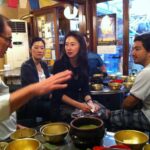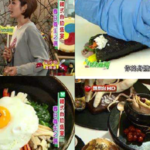table of contents
Visiting Seoul during a mid-winter freeze isn’t something I’d recommend to anyone unless, like me, you go there to eat. The few trees are leafless, the local’s faces are sullen with a determination to keep warm and trips to the local sights, such as the beautifully stark outdoor royal palace, only make you want to retreat to a heated room. Luckily, Daniel Gray is there to save us all with his nighttime eating and drinking tour. This is the delicious side of Seoul where you can get as warm and tipsy from the atmosphere as from the mugwort beer. And any time of year, the food is excellent.
I don’t often take tours but Dan’s came highly praised by a foodie friend, so I decided to try it. Dan is a Korean American who started a food blog after moving to Seoul to find his roots. As his blog grew, people began asking him to take them to the places he wrote about, so about a year ago he started a culinary tour company and cooking school called O’ngo Food Communications with his friend and chef, Jia Choi.
The night tour is done using local transport or on foot. On the night of our tour, our first stop is barbecue. Dan leads me through an alleyway thick with steam from food stall workers washing their dishes on the sidewalk. The humble neon shop signs and a row of rudimentary restaurants look eerily like futuristic scenes in the movie Blade Runner. Our destination is a basic stall-style restaurant covered in clear plastic to keep out the cold. The small tables each have a charcoal barbecue at their center and the place is packed with locals. It smells like cooking pork and the damp air is warmed by body heat and hot grills.We find a table crammed between two others and Dan begins ordering in Korean. We get a few kinds of pork, the best-being garnaeggisal, a cut from near the lungs and back, which we grill alongside whole mushrooms and cloves of garlic. We dip the cooked meat in a bean and chili paste mixture called samjang, then wrap it in gaennip (sesame leaf). To wash this down, we drink shots of cheongha, a rice alcohol that tastes like sweet sake. Of course, I’m the only non-Asian in the place but all that earns me is a few fleeting smiles.
“Save room,” Dan tells me as I down another perfect, caramelized pork skewer after complaining about being full.
Next, we walk to a small cafe called Pub of the Blue Star. It’s an artsy place with young couples snuggling in the corners, the unpainted wood walls decorated with the owner’s travel photographs. We sit at a simple round table with small bench seats. Again Dan orders in Korean, and soon we’re served what looks like a miniature witch’s cauldron full of green pond scum.
“It’s called makgeolli– it’s better than it looks,” Dan says, noting my confused expression. “Do you know what mugwort is?”
I do know. It grows in the US and hippies uses it to have good dreams – or something. Dan ladles the pea green, frothy drink into our bowls. The rustic drink is known as “farmer’s beer,” and it’s delicious: slightly fizzy, subtly spicy and something I could drink vats of if not careful. The owner makes several other variations such as green tea and mulberry, and I’d like to try them all but decide to stick with one for sobriety’s sake. So we drink the makgeolli with the cafe’s tasty homemade kimchi and talk food.
I, of course, want to try live octopus, since that’s what I’ve heard is a specialty here. I have an idea that the critters are tiny, like bite-sized wriggling cheese puffs.
“Um, not really,” says Dan. “In fact, I took some people this morning and they ate some. Do you want to see the video I took on my phone?”
He shows me a terrifying clip of a man stuffing a fist-sized octopus in his mouth with a chopstick. The octopus is slathered in sesame oil to make it go slick down the gullet.
“Around four people die every year from eating octopus this way,” Dan explains. “The tentacles grab onto your windpipe and strangle you.”
OK, let’s skip the octopus. Instead, Dan suggests we go to the market to eat pancakes called pajeon. I tear myself away from the yummy mugwort brew and again we walk through the cold steaming streets. The market starts in what feels like a mid-city pedestrian tunnel, damp and strewn with litter. We pass vegetable sellers, then the tunnel opens to a wider, covered area stuffed with restaurant stalls and vendors.
It’s getting late and some places are closing but there are still plenty of bubbling pots of soup, fresh fish on display and groups of locals bent over bowls of noodles. We go into a shop where pajeonare being fried up by a grinning grandma. The place is full of young people. Dan orders the specialty modumjeon, a mix of pan-fried snacks made from spam, flounder, kimchi and tofu alongside mung bean pancakes. This is all to be eaten with shots of soju, Korea’s national drink. There are two sojuvarieties: “original,” which is 20.1% alcohol, and “fresh,” which is slightly less challenging at 19.5%. Both taste like paint thinner to me, but I manage a few shots. Everyone around us is downing sojulike water. Meanwhile, the eggy, protein- and vegetable-rich pancakes are just the healthy, salty type of thing that goes down well with drinking.
At the end of the night, I’m not only full, warm and a bit drunk — I also feel like I’ve tasted the best food in town without feeling like a dumb tourist. Dan has been a fabulous company. During my next trip to Korea, I’ll definitely take his daytime market tour – but I think I’ll skip the live octopus.
For more information on O’ngo Food Communications: www.ongofood.com.
by Celeste Brash on Nov 4, 2011






